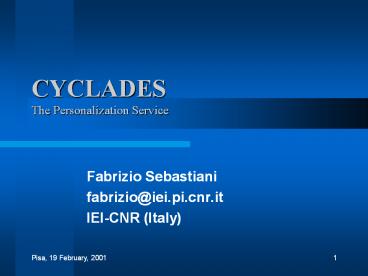CYCLADES The Personalization Service - PowerPoint PPT Presentation
Title:
CYCLADES The Personalization Service
Description:
The user's interests are viewed as a hierarchically structured set of topics, ... to have a non-null error rate: the user is thus allowed to correct the ... – PowerPoint PPT presentation
Number of Views:45
Avg rating:3.0/5.0
Title: CYCLADES The Personalization Service
1
CYCLADESThe Personalization Service
- Fabrizio Sebastiani
- fabrizio_at_iei.pi.cnr.it
- IEI-CNR (Italy)
2
Main goal
- The Personalization Service (PS) is responsible
for allowing a user to interact with the system
in a flexible and highly personalized way.
3
Personalization as a topic-driven activity
- Personalization is viewed as a content-based
notion i.e. the interaction with the user must
take into account the users interests. - The users interests are viewed as a
hierarchically structured set of topics, each of
which represents the users subjective view of a
discipline which is of interest to her. - Personalization is achieved by
- Creating and maintaining a set of topic profiles
(i.e. internal representations of topics) - Letting the information seeking/presenting
behaviour of the system be influenced by these
profiles.
4
User topics and community topics
- Topics (and their profiles) may belong to
- a particular user (user-specific topics).
- a particular community (community-specific
topics). Any user has a default subscription to
the topics belonging to a community she is a
member of, and may selectively cancel these
subscriptions. - The topics that pertain to a user are thus the
union of - the topics that belong to the user as an
individual - the topics that belong to the communities the
user is a member of.
5
An example topic hierarchy
Information Retrieval
Fuzzy Logic
Digital Libraries
Umbertos CYCLADES folder
Possibilistic Logics
Logics for Uncertainty and Imprecision
Logics of subjective probability
Probabilistic Logics
Logics of objective probability
6
Topic-based personalization
- Personalization influences the behaviour of the
system in - Seeking information
- Presenting the retrieved information to the user
- both when it operates
- in ad hoc mode
- in on-demand mode
7
Personalization in the ad hoc mode
- Ad hoc (pull) mode the system delivers to the
user information it deems relevant to a specific
request she has just explicitly issued. - This modality is apt to serve user information
needs of a contingent (temporally local) nature. - For personalization, the topic profiles of the
user and of the communities to which the user
belongs are to be used globally (thus forming a
user profile) as "background information" that
allow the request to be understood in the context
of the users long-term interests.
8
Personalization in the on demand mode
- On demand mode the user asks the system to
deliver to her any information that might have
recently become available and that is relevant to
her own interests. - This modality is used to satisfy information
needs of a permanent or semi-permanent
(temporally global) nature. - For personalization, each of these profiles is to
be used as a standing (i.e. permanent) query.
9
Classification of results
- The PS further provides personalized automatic
classification of the records resulting from the
(either ad hoc or on-demand) information-providing
activity, into a set of hierarchically organized
folders, each corresponding to a topic. A topic
profile is thus (the declarative part of) a
classifier, i.e. a tool that can automatically
decide whether an item is relevant or not to the
topic - Any automatic classifier is going to have a
non-null error rate the user is thus allowed to
correct the classifiers decisions that she
perceives as wrong
10
How are classifiers built and updated?
- The classifier is automatically built by learning
from items the user has classified manually. - The classifier is automatically updated by
interpreting implicit user feedback, consisting
of - moving an item from folder A to folder B
- deleting an item from folder A
- aliasing an item from folder A to folder B
- Updates reflect
- errors by the classifier
- semantic shifts in the meaning of the involved
topics
11
Dynamic topic hierarchies
- The user (or the community owner) may decide
herself how to structure the topic hierarchy
initially a single-node hierarchy is the default - The topic hierarchy is dynamic, as the user (or
the system, after user approval) may restructure
it by - Splitting a topic into several subtopics
- Collapsing the subtopics into a single topic
- Deleting a topic
12
Some technical issues
- Topic profiles will be inductively built and
updated by supervised learning techniques we
plan to use incremental classification techniques
(e.g. Balanced Winnow) - The hierarchical topic structure will be
dynamically modified by unsupervised learning
techniques (i.e. clustering) - The classifiers will be evaluated and optimized
using user-dependent utility measures (e.g.
giving different penalties to errors of
commission and errors of omission).
13
The PS and the Mediator Service
- When the MS interacts with user X, the PS feeds
to the MS the topic profiles (resp. user profile)
of X that the QBS uses to issue on-demand X
queries (resp. to personalize ad hoc X queries) - The QBS feeds to the PS the results of these
queries that the PS classifies in the topic
hierarchy specific to the user. - The MS informs the PS of user actions (such as
moving, deleting or aliasing records across
folders) that the PS may use for updating topic
profiles and/or restructuring (upon user
approval) the structure of the topic hierarchy.































